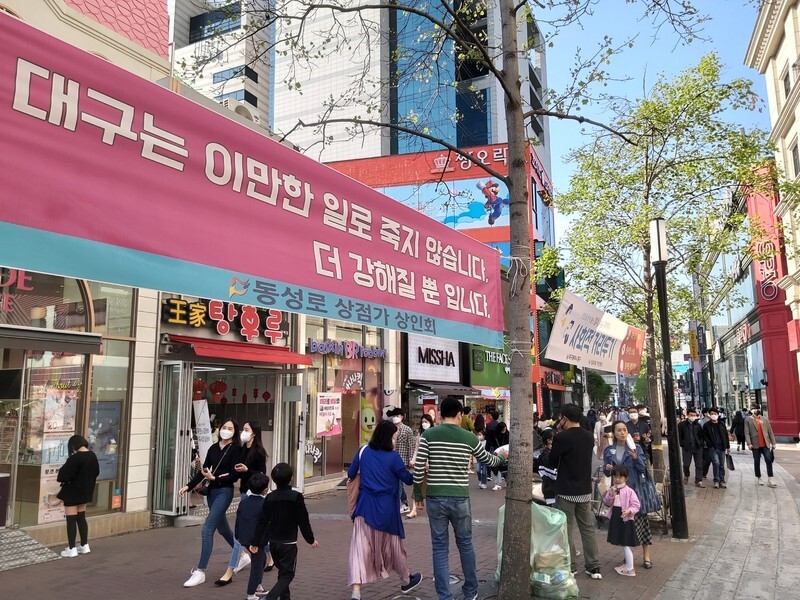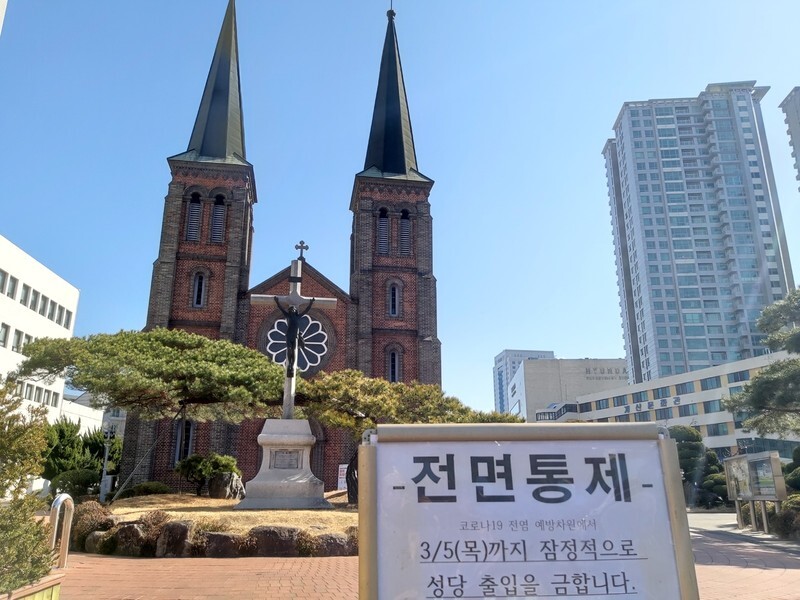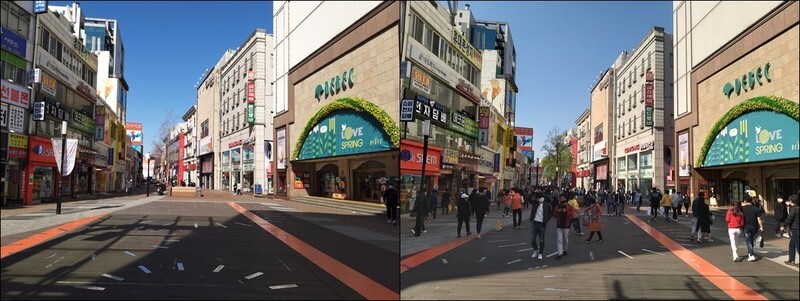hankyoreh
Links to other country sites 다른 나라 사이트 링크
[Reportage] Recounting Daegu’s battle with the worst of S. Korea’s COVID-19 epidemic

The South Korean metropolis of Daegu saw its first COVID-19 case on Feb. 18, 29 days after the country reported its first case on Jan. 20. After that, the city became the front line of the war against the coronavirus. While the city faced a crisis in which hundreds of patients were diagnosed every day, the diligence of its citizens and help from around the country have enabled a gradual return to normal life. Kim Il-woo, the Hankyoreh’s Daegu correspondent, outlines the bitter struggle of the past 72 days.
“Yesterday, the city of Daegu diagnosed 741 new cases of COVID-19, bringing the total to 2,055,” said Daegu Mayor Kwon Young-jin, his face grim, during the daily coronavirus briefing at Daegu City Hall on 10:30 am, Feb. 29.
“The number of hospital beds available to us isn’t nearly adequate to keep up with the surge in patients, and we’re also dealing with a severe shortage of medical staff in the field. Each day, people are losing their lives as they wait to be assigned a hospital bed, and our citizens’ fear about more infections is soaring.”
Kwon’s face grew darker as he struggled to read his prepared speech. When the first patient from the Daegu branch of the Shincheonji religious sect (the 31st patient nationwide, a 61-year-old woman) tested positive on Feb. 18, no one could have expected the situation would blow up like this. But 2,000 new cases had been reported in just 10 days, and anxiety filled the briefing room. The 31st patient, a Shincheonji follower who was discharged 67 days after being hospitalized, has become known as the country’s most famous “super spreader” because of the large number of people she came into contact with while infected.
Fear was evident on the faces of the reporters whispering among themselves. “If there were 741 cases in a single day, there might be more than a thousand tomorrow.” “We’re really in trouble now!”
One evening a few days later, I was heading home after work when I dropped by the Jongno thoroughfare in downtown Daegu, an area popular with the younger crowd. At normal times, the neighborhood would have been bustling with people, but I didn’t see a single soul. Only a handful of the 50 or so shops in the area were open, and even those didn’t have any customers. It was a surreal moment that encapsulated the silence and terror gripping the city.

Daegu has the most major hospitals of the country’s six metropolitan cities, a category that includes Busan, Incheon, Gwangju, Daejeon, and Ulsan, and excludes the capital of Seoul. Even so, the city’s vaunted medical infrastructure was humbled by the coronavirus. The city has 10 general hospitals and five tertiary hospitals, with enough beds for 7,000 patients. It even has a regional public hospital (called the Daegu Medical Center), unlike major cities like Gwangju, Daejeon, and Ulsan.
After the coronavirus outbreak began, the Keimyung University Dongsan Medical Center completely dedicated the Daegu Dongsan Hospital to combating the disease, while other hospitals — including the ROK Army Daegu Hospital, Daegu Veterans’ Hospital, and a Daegu hospital operated by the Korea Workers’ Compensation and Welfare Service — set aside hospital beds. But it wasn’t enough to handle the huge number of patients.
One after another, people who shouldn’t have come down with COVID-19 tested positive and were put into quarantine, including the head of infectious disease prevention at Daegu’s Seo (West) District Community Health Center (on Feb. 22), a police officer at the Dong (East) District Police Department (on Feb. 24), and a secretary for the city’s vice mayor for economic affairs (on Feb. 25). Rumors were going around that some reporters had tested positive and that others had quarantined themselves. Several of my friends came down with a fever and confined themselves at home as they waited for test results.

With nearly 2,000 patients waiting for space to open up at hospitals, there were frequent reports of people dying at home. A 50-year-old man who’d tested positive and was waiting for a hospital bed sobbed during a telephone interview on Mar. 1. “I’m stuck at home [because there aren’t any hospital beds], and I’m worried that I’m going to infect my wife, who’s not in good health.”
A solution was found for housing the overwhelming number of patients: asymptomatic patients and those with mild symptoms were sent to “residential treatment centers,” government offices and hotels in the area that were repurposed to quarantine and treat them. While the government’s initial guidelines for responding to the outbreak called for all patients to be hospitalized, those guidelines were revised on Mar. 1, and the backlog of patients started to fall after 15 residential treatment centers opened up around the country.

As the number of patients increased, people became more suspicious of everyone around them. “I’m not infected, am I?” “Do you think that guy over there has it?” The atmosphere of distrust was almost unbearable.
Conversations often began with the question, “Please tell me you’re not a member of Shincheonji.” Sure enough, Shincheonji members accounted for 60% of the cases in Daegu (4,261 out of 6,852 cases reported through Apr. 28).
After the residential treatment centers came into operation and testing wrapped up (on Mar. 10) on all members of the Shincheonji church that had been the epicenter of the Daegu outbreak, stability gradually returned to the city. On Mar. 12, the number of people being released from quarantine exceeded the number of new cases for the first time, marking the much-anticipated “golden cross.”
Since Apr. 8, Daegu’s daily number of new cases has remained in the single digits. The contagion has been completely halted at the city’s major infection clusters. The Second Miju Hospital (196), Hansarang Nursing Home (128), and Daeshil Nursing Home (100) saw their final cases between Apr. 15 and 22. On Apr. 19, the city ended its daily coronavirus briefings.
How was Daegu able to beat COVID-19? That was the question that Research Korea posed to 1,008 Daegu residents aged 20 and above on Apr. 17-21 as part of a survey commissioned by the city. Survey respondents credited the efforts of medical personnel, firefighters, soldiers, public servants, and volunteers and citizens’ voluntary participation in social distancing.
Assistance from the central government and other local governments also made a big difference. The central government funneled medical resources, including staff and equipment, to the city, while other areas were able to take in patients from Daegu for treatment and send over their own medical workers and equipment. That was possible because, fortunately enough, there were no major outbreaks in other regions while Daegu was waging its war against the coronavirus.
Social cooperation and lack of tourists helped contain virusDaegu’s conservative culture and lack of tourists also worked to the advantage of disease control efforts. The conservative citizens of Daegu, who tend to cooperate with authorities, embraced the social distancing campaign. In the first week of March, usage rates on the city bus network and subway dropped by 31.8% and 25.4%, respectively, compared to typical figures. According to a joint survey by city officials and the police on Apr. 12, when the number of new cases had started to decline, 1,202 of 1,332 nightlife establishments (90.2%) were closed. The fact that Daegu doesn’t get many tourists was a factor that prevented the outbreak from spreading to other major cities.
“We were able to get help from other areas because most of the country’s cases occurred in Daegu, but there’s no guarantee that we’ll be so lucky if the coronavirus returns. During this brief pause in the outbreak, the city of Daegu needs to build up its own disease control capacity, sharpen the skills of its public servants, and draw up a detailed response manual,” said Eun Jae-sik, secretary-general of a Daegu NGO called Citizens’ Welfare Coalition.
“This won’t kill Daegu — it will only make us stronger.” The message appeared on a banner strung up on Dongseongno, a street in Daegu’s Jung (Central) District, on the afternoon of Apr. 26.
The street was packed with people in masks. Most of the shops that had shut down two months ago were open for business again. Signs attached to the entrance to each shop asked customers to wear a mask while inside.
At restaurants and bars, employees checked visitors’ temperature before letting them in. Whenever the light turned green at the crosswalk in front of the CGV Daegu Hanil theater, a hundred or so people crossed the road — compared with barely 10 people two months before.
“When the coronavirus was spreading through Daegu, I hardly left the house for over a month. But nowadays, I’ve returned to my everyday routine, though I’m staying as cautious as possible. At first, I thought we were really in for it, but fortunately the situation was resolved sooner than I’d expected. This crisis has taught me to appreciate my everyday routines,” said Park Seon-yeong, 32, whom I met on Dongseongno.
People remain vigilant, but daily life has returned to Daegu. On Apr. 29, the percentage of Daegu’s coronavirus patients who’ve been released from quarantine climbed above 90% for the first time.
By Kim Il-woo, Daegu correspondent
Please direct comments or questions to [english@hani.co.kr]

Editorial・opinion
![[Column] Has Korea, too, crossed the Rubicon on China? [Column] Has Korea, too, crossed the Rubicon on China?](https://flexible.img.hani.co.kr/flexible/normal/500/300/imgdb/original/2024/0419/9317135153409185.jpg) [Column] Has Korea, too, crossed the Rubicon on China?
[Column] Has Korea, too, crossed the Rubicon on China?![[Correspondent’s column] In Japan’s alliance with US, echoes of its past alliances with UK [Correspondent’s column] In Japan’s alliance with US, echoes of its past alliances with UK](https://flexible.img.hani.co.kr/flexible/normal/500/300/imgdb/original/2024/0419/2317135166563519.jpg) [Correspondent’s column] In Japan’s alliance with US, echoes of its past alliances with UK
[Correspondent’s column] In Japan’s alliance with US, echoes of its past alliances with UK- [Editorial] Does Yoon think the Korean public is wrong?
- [Editorial] As it bolsters its alliance with US, Japan must be accountable for past
- [Guest essay] Amending the Constitution is Yoon’s key to leaving office in public’s good graces
- [Editorial] 10 years on, lessons of Sewol tragedy must never be forgotten
- [Column] A death blow to Korea’s prosecutor politics
- [Correspondent’s column] The US and the end of Japanese pacifism
- [Guest essay] How Korea turned its trainee doctors into monsters
- [Guest essay] As someone who helped forge Seoul-Moscow ties, their status today troubles me
Most viewed articles
- 1[Column] The clock is ticking for Korea’s first lady
- 2Hong Se-hwa, voice for tolerance whose memoir of exile touched a chord, dies at 76
- 3[Column] Has Korea, too, crossed the Rubicon on China?
- 4After 2 months of delayed, denied medical care, Koreans worry worst may be yet to come
- 5[Correspondent’s column] In Japan’s alliance with US, echoes of its past alliances with UK
- 6All eyes on Xiaomi after it pulls off EV that Apple couldn’t
- 7[Photo] Smile ambassador, you’re on camera
- 8US overtakes China as Korea’s top export market, prompting trade sanction jitters
- 9S. Korea “monitoring developments” after report of secret Chinese police station in Seoul
- 1075% of younger S. Koreans want to leave country